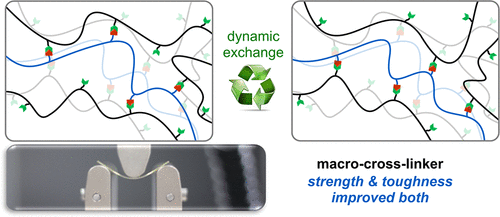当前位置:
X-MOL 学术
›
Macromolecules
›
论文详情
Our official English website, www.x-mol.net, welcomes your
feedback! (Note: you will need to create a separate account there.)
Strong, Reconfigurable, and Recyclable Thermosets Cross-Linked by Polymer–Polymer Dynamic Interaction Based on Commodity Thermoplastics
Macromolecules ( IF 5.1 ) Pub Date : 2020-01-21 , DOI: 10.1021/acs.macromol.9b02325 Zongtao Wang 1 , Yu Gu 1 , Mingyu Ma 1 , Mao Chen 1
Macromolecules ( IF 5.1 ) Pub Date : 2020-01-21 , DOI: 10.1021/acs.macromol.9b02325 Zongtao Wang 1 , Yu Gu 1 , Mingyu Ma 1 , Mao Chen 1
Affiliation

|
Polymer networks cross-linked by dynamic covalent bonds possess outstanding mechanical and rheological properties and are expected to be potential alternatives to conventional thermosets. However, while many recent studies of dynamically cross-linked thermosets focused on the employment of small molecular cross-linkers, the macro-cross-linking approach and the corresponding thermosets have been less demonstrated. In this work, reconfigurable and catalyst-free thermosets were synthesized by dynamic polymer–polymer interaction based on reversible boronic ester bond, providing simple and efficient access toward materials with improved mechanical strength and toughness in comparison to related commodity thermoplastics. The dynamic exchange of covalent bonds dispersed between polymer chains enables the materials to be malleable, recyclable, and healable under thermal conditions and readily processable with mechanical mixing without solvent. Moreover, the materials’ mechanical and rheological properties could be tuned by changing the cross-linking density. Although the dynamic networks exhibited good resistance against organic solvents, they could be cleaved as triggered by acids or diols and recycled through the de-cross-linking/re-cross-linking pathway. Given the dramatically increasing interest in environmentally sustainable materials, this polymer–polymer interaction mode provides a robust approach to engineering polymers with improved performance compared with the thermoplastic counterparts.
中文翻译:

基于商品热塑性塑料的高分子-聚合物动态相互作用交联的牢固,可重构和可回收的热固性材料
通过动态共价键交联的聚合物网络具有出色的机械和流变性能,有望成为常规热固性材料的潜在替代品。但是,尽管最近对动态交联的热固性塑料的许多研究都集中在使用小分子交联剂上,但宏观交联方法和相应的热固性塑料的研究却很少。在这项工作中,通过基于可逆硼酸酯键的动态聚合物-聚合物相互作用,合成了可重构和无催化剂的热固性材料,与相关的商品热塑性塑料相比,可以简单有效地获得具有改善的机械强度和韧性的材料。分散在聚合物链之间的共价键的动态交换使材料具有延展性,可回收利用,并在热条件下可治愈,并且在没有溶剂的情况下通过机械混合即可轻松进行加工。而且,可以通过改变交联密度来调节材料的机械和流变性能。尽管动态网络对有机溶剂显示出良好的抵抗力,但它们可以被酸或二醇触发而裂解,并通过去交联/再交联途径再循环。鉴于人们对环境可持续性材料的兴趣日益增长,与热塑性材料相比,这种聚合物-聚合物相互作用模式为工程聚合物提供了一种性能更高的可靠方法。可以通过改变交联密度来调整材料的机械和流变性能。尽管动态网络对有机溶剂显示出良好的抵抗力,但它们可以被酸或二醇触发而裂解,并通过去交联/再交联途径再循环。鉴于人们对环境可持续性材料的兴趣日益增长,与热塑性材料相比,这种聚合物-聚合物相互作用模式为工程聚合物提供了一种性能更高的可靠方法。通过改变交联密度可以调节材料的机械和流变性能。尽管动态网络对有机溶剂显示出良好的抵抗力,但它们可以被酸或二醇触发而裂解,并通过去交联/再交联途径再循环。鉴于人们对环境可持续性材料的兴趣日益增长,与热塑性材料相比,这种聚合物-聚合物相互作用模式为工程聚合物提供了一种性能更高的可靠方法。
更新日期:2020-01-22
中文翻译:

基于商品热塑性塑料的高分子-聚合物动态相互作用交联的牢固,可重构和可回收的热固性材料
通过动态共价键交联的聚合物网络具有出色的机械和流变性能,有望成为常规热固性材料的潜在替代品。但是,尽管最近对动态交联的热固性塑料的许多研究都集中在使用小分子交联剂上,但宏观交联方法和相应的热固性塑料的研究却很少。在这项工作中,通过基于可逆硼酸酯键的动态聚合物-聚合物相互作用,合成了可重构和无催化剂的热固性材料,与相关的商品热塑性塑料相比,可以简单有效地获得具有改善的机械强度和韧性的材料。分散在聚合物链之间的共价键的动态交换使材料具有延展性,可回收利用,并在热条件下可治愈,并且在没有溶剂的情况下通过机械混合即可轻松进行加工。而且,可以通过改变交联密度来调节材料的机械和流变性能。尽管动态网络对有机溶剂显示出良好的抵抗力,但它们可以被酸或二醇触发而裂解,并通过去交联/再交联途径再循环。鉴于人们对环境可持续性材料的兴趣日益增长,与热塑性材料相比,这种聚合物-聚合物相互作用模式为工程聚合物提供了一种性能更高的可靠方法。可以通过改变交联密度来调整材料的机械和流变性能。尽管动态网络对有机溶剂显示出良好的抵抗力,但它们可以被酸或二醇触发而裂解,并通过去交联/再交联途径再循环。鉴于人们对环境可持续性材料的兴趣日益增长,与热塑性材料相比,这种聚合物-聚合物相互作用模式为工程聚合物提供了一种性能更高的可靠方法。通过改变交联密度可以调节材料的机械和流变性能。尽管动态网络对有机溶剂显示出良好的抵抗力,但它们可以被酸或二醇触发而裂解,并通过去交联/再交联途径再循环。鉴于人们对环境可持续性材料的兴趣日益增长,与热塑性材料相比,这种聚合物-聚合物相互作用模式为工程聚合物提供了一种性能更高的可靠方法。











































 京公网安备 11010802027423号
京公网安备 11010802027423号